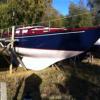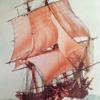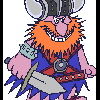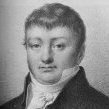MORE HANDBOOKS ARE ON THEIR WAY! We will let you know when they get here.
×
-
Posts
629 -
Joined
-
Last visited
Reputation Activity
-
 kruginmi got a reaction from Kevin in HMS Druid by Krug - FINISHED - 1:48 - Hahn
kruginmi got a reaction from Kevin in HMS Druid by Krug - FINISHED - 1:48 - Hahn
I will skip over the ice storm, providing refuge to a family of 8, car issues, the holidays and such and actually do some modeling on the last day of 2013: The object is the stove stack.
Into my stove I had cut a slot for an 1/4" brass tube which I procured locally. Luckily I decided to just put everything in place with this oversized tube 'just to make sure.' Well, it was very obvious the angle was significantly off:
Pondering this it all made sense. The stove was sitting on a deck that had a slight pitch up towards the stem. Looking at the plans the base of the stove was indeed angled to allow the stove / pots to sit level with the water line. how many times have I looked at these and never seen that? So I added the appropriate shim and brought the angle to rights:
With that taken care of I was able to use the deck beams to mark off the different levels. These checked out with the plans (always a good thing) and I identified the height and angle required which I cut out with a very fine toothed straight saw:
After some silver soldering (got so excited I didn't take any pictures) the pipe was complete. A good result for not so much work. It still needs to be blackened but this will wait. I really like the solid feel while still able to remove it out of the way for now.
This pipe now sits as Mr. Hahn constructed it. I am still scratching my head if I will go ahead and construct the brass cover assembly. Next job is the berth deck waterway so I can start planking that deck in.
Merry Christmas and Happy New Year,
mark
-
 kruginmi got a reaction from Elmer Cornish in HMS Druid by Krug - FINISHED - 1:48 - Hahn
kruginmi got a reaction from Elmer Cornish in HMS Druid by Krug - FINISHED - 1:48 - Hahn
Whew! When I decided to 'knock' out the rudder I had no idea the task I had set myself on. Luckily, I say that looking back! That's right, the rudder is finally in the rear view mirror. This morning I escaped from the family and fashioned the blocks and rigging necessary to get every thing ship shape. A very big day in the life of Druid.
I will post a couple pics of the obligatory rigging components. Very tight spaces, small pieces and trying to get everything to match up with the plan. First in the rough with all the stropping added and the synching up required.
Now for some clean-up and final looks (before it disappears into the depths of the hull:
Finally, I put it all together (looking at the plan MANY times to insure each side was a mirror of the other and corresponded to the plans):
Unfortunately, everything starts to disappear as the next level carings and ledges are added:
As you can see I did need to cut out a little of the mast centering piece that was in the way, but this is to be all under floor planks. Still need to run everything up to the ships wheel which will provide the needed tension to keep everything a little straighter.
I now get to think about this (small) victory for at least the rest of the day, before I move on to the next job.
Mark
-
 kruginmi got a reaction from Kevin in HMS Druid by Krug - FINISHED - 1:48 - Hahn
kruginmi got a reaction from Kevin in HMS Druid by Krug - FINISHED - 1:48 - Hahn
I have had limited time in the shipyard but have been working on those blocks for quite awhile and still not satisfied with the result. They look a whole lot better then above by going on a weight loss plan (width and length). I almost just gave in and went to stropping them when I suddenly realized - this was My Druid. Then it came to me - why make the blocks like kit blocks??
I went and fashioned ones by the numbers in less than an hour (a lot less time than the previous attempt!). Below is a picture of the blocks in mid-construction. I did glue the inner sheave to the block itself. You can see the jig I made up to cut the sheave off of a hardwood dowel. The outer layer is 1/16 inch basswood, the inner one 1/32 inch.
Once glued up, I cut each middle layer at the mid-way point. With just a little shaping I compared this with the previous attempt:
This is SO much faster than trying to hack out of a solid block (for me) and the result looks so much better. I will still do some shaping to reduce the overall width but that is very straight forward. Each block looks the same and somewhat accurate also. To add the external groove for the stropping to ride in I used a special cutter attachment on my dremel:
On any 1:48 scale model (or larger) I will always use this method for blocks. NOW I can finally think about stropping.
Mark
-
 kruginmi got a reaction from Kevin in HMS Druid by Krug - FINISHED - 1:48 - Hahn
kruginmi got a reaction from Kevin in HMS Druid by Krug - FINISHED - 1:48 - Hahn
After a bunch of fits and starts I finally tried my hand at some rigging blocks for the tiller. Of course these will not be seen, being buried in the back of the berth deck. I will say the effort for these things is not inconsequential.
I think I still have another hour or so of refining individual blocks to bring out their best. With only eight to make I didn't build up any sort of jig. With any more, this would have been a requirement.
On the question of stropping I am leaning towards using wire and extending that wire to allow the block to be fixed to the hull. With the tension from the tiller rope they should be very taught and basically parallel to the deck. I am worried using rope a sag will result. Not trying to think too much!
mark
-
 kruginmi got a reaction from Kevin in HMS Druid by Krug - FINISHED - 1:48 - Hahn
kruginmi got a reaction from Kevin in HMS Druid by Krug - FINISHED - 1:48 - Hahn
Finally on the other side of that rudder. This whole assembly was a whole lot more than I ever thought it was going to be. I will never look at a rudder the same way again!
I am pretty proud of the result - kids actually looked up from their IPODS when I went to show them so I will take that as a compliment. At least the three year old was audibly impressed. I can actually think of buttoning up that berth deck now (once I get the tiller arm rigged in, well, once I make the blocks so I can rig the tiller arm in....).
Oh well, Here is to the Victories of Today!
Mark
-
 kruginmi got a reaction from Kevin in HMS Druid by Krug - FINISHED - 1:48 - Hahn
kruginmi got a reaction from Kevin in HMS Druid by Krug - FINISHED - 1:48 - Hahn
Things you never learn growing up......
I never knew you can buy sewing pins with different sized pin heads! I have been almost stopped on the Druid trying to figure out how to produce all those bolt heads required. I tried a number of things without much success. Finally I just picked up my (almost worn out, threadbare) Hahn book and re-read the Druid chapter.
Low and behold, he mentions using pins (as well as touching up the blackened brass with paint). I quickly took the pins I had and knew the head was oversized and not right. The next day I stopped by the local sewing shop and was amazed by the wall of pins. They were sorted by type, metal content and finally - HEAD SIZE! Am I the only one to not know this?
I had hoped for brass but after a certain size the only available was nickel plated steel. I hoped it would blacken. I had brought some sample brass strapping and figure out the size 8 head was the correct size. So for $3.50 I had 350 pins.
When I got home I plunked one in the blackening solution and it quickly turned black - success! In just an hour or so I had the rudder all bolted in. The next picture is fuzzy but it shows progress where before there was none:
All the touching and pushing to get the bolts into their pre-drilled holes (with super-glue) defintely required some touch up (as previously talked about). I used some flat black paint and it looked as good as new.
Now that I am over that mental hurdle, this weekend the job is to get the rudder totally mounted to the hull.
mark
-
 kruginmi got a reaction from Kevin in HMS Druid by Krug - FINISHED - 1:48 - Hahn
kruginmi got a reaction from Kevin in HMS Druid by Krug - FINISHED - 1:48 - Hahn
With the time available I am slowly progressing forward. An inventory of my brass supply showed I had insufficient stock for all the work I needed to do (especially when I think about scrap!). I had previously bought it pre-cut but opted to take the dive this time and buy it as a sheet and cut it as needed:
Wasn't that bad to score and snap off the strips I need. I will save a little $$ with this and feel my skills have advanced a little.
Previously when I worked with the cylinder brass I always inserted the matching rod to hold the tube in place against the strapping. Well, the next two times with silver solder the rod was welded in place as well as the cylinder. As I pondered the imponderables the obvious came to me: do not cut the cylinder to shape until after it is affixed to the strapping:
Sample fittings showed that the hull side hinge needed to be offset from the hull more than what the base strapping allowed, so another piece of brass was added. The strapping was bent to hold the new piece firm during heating and soldering, then bent afterwards back to shape. Worked like a charm.
With the new pieces attached to their rudder join part, this was put against the hull and the required attachment point was identified. I did mark where the strapping layed against the hull and once again chiseled out that area for added strength and accurate positioning. I decided to add the wood under the straps where the planking was absent.
The final shot is the bottom two rudder hinges roughed in. I need to do the same to the top hinges and then make the holes for the faux bolts. I can say the rudder is suspended on its own. It can move freely and is centered, so I am happy with the progress.
Keeping moving forward,
Mark
-
 kruginmi got a reaction from Kevin in HMS Druid by Krug - FINISHED - 1:48 - Hahn
kruginmi got a reaction from Kevin in HMS Druid by Krug - FINISHED - 1:48 - Hahn
Still working along but good to see some progress. All I have left on this rudder is all the scale nails to hold the strapping on - hopefully tonight.
The top three bands and the tiller arm bands are from wrapped paper. These areas are not seen on the finished ship so I thought it a great place to try out the technique. Worked very well and I will add to my options in the future.
I added a faux end post on the stern of the rudder. The actual tiller arm was cut down to a more manageable square and inserted into a hole that was initially drilled then squared off. You can't tell. The backup up tiller hole had to be more lifelike but after methodical progress turned out great.
The true test is to try out the resultant work in the space and see if everything lines up. Success. I love it when a plan comes together.
I need to power through those scale nails. I had no idea how much effort and beauty rudders have. Chemistry, metallurgy, shaping, joinery... If you can do a successful rudder you can do an entire ship.
Mark
-
 kruginmi got a reaction from Kevin in HMS Druid by Krug - FINISHED - 1:48 - Hahn
kruginmi got a reaction from Kevin in HMS Druid by Krug - FINISHED - 1:48 - Hahn
Thanks Brian and Lou - slow but keeping at it!
I started to blacken the metal and thought I would share my approach (this did not come easy at first!)
The process includes three containers that each metal piece goes through, acetone, blacken it (thinned) and finally water. I will not touch the piece until it has finished through the process, only with forceps.
The acetone is used to thoroughly clean the metal and is left in for 10 - 15 seconds, with some mild shaking of the container to insure no air bubbles or contact with the bottom of the container is masking some oil. Upon completion the parts are patted dry. On a side note, I get my acetone in small quantities by going to the nail polish remover aisle of the general store.
The blacken- it solution is 1 part patina, 10 parts water. Any more and the solution produces globs of black stuff that wipe off the metal and is quite messy. This was my initial mistake years ago. The green measuring cup is from a Miracle-Gro mix and is perfect - the small end for blacken-it, the large end for water. The parts generally go in for about 5 minutes or so with some mild shaking again. Again, patted dry upon completion.
The water is to wash off any blacken-it remaining then a final patting dry. The results on the top two pieces of the rudder metal work are the result of this process. Pretty straight forward one you have the right chemicals!
I have opted to hand drill the holes in the metal and other than sore fingers the going is fine. Tomorrow I hope to make some scale nails, finish the drilling, and get the metal work affixed. I am thinking about adding rudder chains so that may be a little more work.
Cheers, mark
-
 kruginmi got a reaction from Kevin in HMS Druid by Krug - FINISHED - 1:48 - Hahn
kruginmi got a reaction from Kevin in HMS Druid by Krug - FINISHED - 1:48 - Hahn
Slowly plugging away at the rudder as time allows. With the silver soldering finally set right I can move forward. The metal work still requires the nail holes drilled and then blackened but I am happy with them.
After soldering the three pieces together it took about an hour to slowly bend and fashion it to the correct profile. After I was satisfied (and the length was cut to its required length) I did mark its profile and chisel it in. As is seen in the pictures, the pieces stay put rather well even before glue and nails. I want to have the rudder work totally done and rock solid before I start the hull side to keep the variables to a minimum.
Still have a rear wood piece on the rudder and then eventually the tiller arm. My goal is to have the rudder basically done by the end of the weekend.
mark
-
 kruginmi got a reaction from Kevin in HMS Druid by Krug - FINISHED - 1:48 - Hahn
kruginmi got a reaction from Kevin in HMS Druid by Krug - FINISHED - 1:48 - Hahn
Finally - the replacement for my silver solder flux showed up in the mail today! This hobby is not just for learning things about wood! It starts that way, but then you have to branch out into all types of finished (shellacs, urethanes and all things acrylic). Just when you get comfortable, metalurgy comes to the forefront and the chemistry of soldering. My mix of supplies are:
This flux works like a charm where all others have failed.
For the gudgeons and pintles (rudder work) I needed to replicate the look with what I had available. With some thinking I opted for prototyping using some brass strips, tube and rod (that fits into the tube). On the hull side I soldered a section of tube to the brass strip on the outside facing. On the rudder side I soldered it on the inside and added a section of rod to allow the two pieces to mate.
This result is still very much in the rough for fitting to their wood sections but I believe the end result that is possible is acceptable.
Now I have to fashion the final assemblies for all the attachment points and insure I am able to drill holes through the brass sheet to allow for the nails. I am currently assuming to make an indent at the right drill locations in the brass, probably use a bit of oil for lubrication and slowly make each required hole. These will be small and I am hoping to not sacrifice too many bits. Suggestions are always appreciated.
Mark
-
 kruginmi got a reaction from Kevin in HMS Druid by Krug - FINISHED - 1:48 - Hahn
kruginmi got a reaction from Kevin in HMS Druid by Krug - FINISHED - 1:48 - Hahn
I got all the beams painted (carilngs and ledgings too) on the sides and underside but nothing photogenic so I skip the attached pic.
I did notice I had not finished the gun deck supports so I had to get a few manufactured. I dug around my odds and ends box and found the original (simple) jig I had made for those things. Wasn't too long before I had the ones required made up.
I do dowel them into the lower deck but skip this step for the top end. Just too hard to get everything aligned.
My biggest hope was to fashion the metal work for the rudder. Pulling down my supplies I found my flux had dried up to look like some meteor just fresh through the atmosphere. I could not find the stuff local and spent days and $$'s trying other stuff that just didn't work. Finally ordered the original stuff and hope to get it later this week:
Handy Flux for soldering or brazing gold, silver, brass, copper 8 oz.
Hopefully more progress to show soon,
Mark
-
 kruginmi got a reaction from Kevin in HMS Druid by Krug - FINISHED - 1:48 - Hahn
kruginmi got a reaction from Kevin in HMS Druid by Krug - FINISHED - 1:48 - Hahn
Finally got the time to put one coat of the gel urethane on the starboard side (to include in between the frames). In the picture of the bow the location of the eking rail was left 'in the raw.' Due to lighting issues, the bow pic is a little washed out.
This wasn't that hard to apply at all. It made the frame components really pop and highlight the plank joins.
I am still looking at applying another coat. This was a good thing to do and I am glad I was pushed in this direction.
Mark
-
 kruginmi got a reaction from Elmer Cornish in HMS Druid by Krug - FINISHED - 1:48 - Hahn
kruginmi got a reaction from Elmer Cornish in HMS Druid by Krug - FINISHED - 1:48 - Hahn
I think I might have a winner. I should have checked the paint section of this forum for potential hints, but after a trip to the local Woodcraft and asking the grizzled veterans there General FInishes Gel Urethane came highly recommended. Now, the label says wipe on and that is a potential issue, but the gel was very viscous and a paint brush worked very well. If you paint it on consistently in one direction, any excess is essentially removed negating the need for wiping. It does need to dry overnight but I am okay with that. I took some surplus steps to verify it can handle small fiddly bits and there was no issue. Definitely no shine like the the other two finishes I tried. No fuzzies or crazy grain rising either.
It recommends 2-3 coats but visually there wasn't much difference so.....one coat for the hard to reach internal surfaces and two coats for everything else. There is a slight change in color and the potential to darken some with age but again I have no issues with that.
Once I start I think it should take about a week of steady work to get it covered. Then I can incrementally do the internal sections as they are completed and ready.
Mark
-
 kruginmi got a reaction from VonHoldinghausen in HMS Druid by Krug - FINISHED - 1:48 - Hahn
kruginmi got a reaction from VonHoldinghausen in HMS Druid by Krug - FINISHED - 1:48 - Hahn
Let's see. Banging headache (hoping it didn't go into a migraine). I did
something to my heel and it hurt to walk. Too many things to do around the
house. So....best just go to the workshop. It was the right cure because a
couple of hours later and I am feeling better (head wise) and I am reflecting on
completing the entry steps (starboard side at least).
Those items had been a little intimidating - why? I don't know. I stumbled
across some 1/32nd inch cutoff discs for my dremel (so much easier than the
1/16th inch), drew up a simple molding pattern and had it quickly cut out. I
actually found a previously cut piece of boxwood that matched the dimensions
required. Some quick scraping and cutting to equal lengths and I was ready to
glue.
I laid down some paint tape to get a straight line and cut out a spacer to
insure they match. The big question was whether the eighth step would rest on
the wales as the plans show....and yes it did.
This almost was too easy. What did I forget or mess up? Still haven't figured
it out yet (hah, hah). Pics are posted. I do laugh to see how the camera
really seems to magnify all the issues, dents and everything wrong that are
invisible otherwise.
One almost oops moment was when I as verifying the distance from the steps to the end of the waist railing - it was too short. A couple of anxious moments before I realized (so many years ago) that I had intentionally left the upper railing long to allow cutting down in the future. So, no issues. Tonight I hope to get the port side done. This will officially end the external hull work (sans the eking rail which waits until the cathead is affixed). The rudder metal work awaits.
Mark
-
 kruginmi got a reaction from Elmer Cornish in HMS Druid by Krug - FINISHED - 1:48 - Hahn
kruginmi got a reaction from Elmer Cornish in HMS Druid by Krug - FINISHED - 1:48 - Hahn
After (finally) getting the college girl out of the house and moved into her apartment I found some time and got the port chesstree and pass through hull blocks roughed in. These will be finalized after the rail is installed in the future.
Pondering all this talk about putting a finish on the hull, I created a little test piece and tried some Minwax Polycrylic. Because basswood so porous nothing works fantastic, but after three coats (sanding between) I wasn't very happy with the result. At certain angles it looks fine, but at others a shiny splotchy residue is evident. The following picture gives a hint of this.
I did try some paste wax and that didn't look too bad but has to be applied with a rag and then buffed out. Not so good for between the frames and anything internal. I am pondering to pick up some clear sealer / shellac and see what that will do. I still have pretty good access - only the berth deck floor is attached. Everything else is currently held by friction and removable trunnels.
If that doesn't work I will probably go back to the original plan - a good case.
Mark
-
 kruginmi got a reaction from albert in HMS Druid by Krug - FINISHED - 1:48 - Hahn
kruginmi got a reaction from albert in HMS Druid by Krug - FINISHED - 1:48 - Hahn
On to the chesstrees. There is definitely a few hours here as will be explained below. My first gut was to jump right in, make a cardboard template to match the hull shape, transfer to a wooden piece and get'r done. Well, I never really like butt joints that show and in this case I was unable to get a real tight fit all around the chesstree. Pause to think.....
Well, the easiest way is to inset the chesstree into the planking. So, I carefully trace around the chesstree and chisel half a plank depth away.
The result is much more satisfying. As a bonus, the joint will be a whole lot stronger.
Now here came the biggest problem to overcome, creating the sheave hole. At first I jumped in and carefully drilled a hole at both ends of the sheave hole and tried to remove any remaining wood in between. I didn't even take a picture as the result was totally unacceptable no matter how much I carefully filed, scraped and poked. I ended up walking away for the night.
Later on the solution came to me and involved keeping it as simple as possible. I would cut into the chesstree to the sheave from the bottom. Once everything was cleaned up (now that the entire hole was accessible this was easy), a small section of wood would be replaced. Very quick and the result I liked very much. The actual block you see is one fashioned quickly and will be replaced.
So overall the process was probably 3.5 hours. The next one for the port side will probably be done in less than half the time but I am okay with that. I ended up with something that looks good and methodically worked through the issues as they came up.
Cheers,
Mark
-
 kruginmi got a reaction from jct in HMS Druid by Krug - FINISHED - 1:48 - Hahn
kruginmi got a reaction from jct in HMS Druid by Krug - FINISHED - 1:48 - Hahn
RIght now I have no plans to. This hull has been around for 8 years (assembled) and been very stable so far. Also, there are already regions I am unable to adequately reach. With basswood really need some sort of sealer.
This whole ship has been a learning experience for me. Most items (where possible) are doweled or positioned with clamps as opposed to glue to allow some movement. I attach an internal pic of the orlop deck which has survived with no ill effects so far.
Loving the hobby,
Mark
-
 kruginmi got a reaction from WackoWolf in HMS Druid by Krug - FINISHED - 1:48 - Hahn
kruginmi got a reaction from WackoWolf in HMS Druid by Krug - FINISHED - 1:48 - Hahn
Today the object was to rough in the pass through blocks, two each side. They will not be installed until the internal planking is complete (for ease of planking).
Their construction was pretty straight forward. I used 1/32" sheet basswood and cut out the box shape pieces. A basic jig was cut out to insure the inner opening was consistent both all the way through the piece, but also all four constructions. These pieces are built considerably over sized to allow for shaping and final fit later.
A small circular piece is inserted to mimic the internal block. After construction the pieces are sanded to thin out the dimensions even further. Once the position on the hull is identified and marked, the hull was drilled through at the four corners and the rest cut out. To cover any gaps upon final install, basswood is great for just injecting a little glue into the gaps and then sanding and pushing the sawdust into filling the gaps.
The inside will have additional supports glued in to insure the pieces go in and out exactly the same. A little time well spent in the shipyard.
Mark
-
 kruginmi got a reaction from daHeld in HMS Druid by Krug - FINISHED - 1:48 - Hahn
kruginmi got a reaction from daHeld in HMS Druid by Krug - FINISHED - 1:48 - Hahn
Greetings (again). Returning to MSW after a bit of off time (eg I just completed my 5th sprint triathlon). I have not been idle and have lately been kicking it into high gear with my version of the HMS Druid. Believe it or not, started in 2003 (two kids and a couple of homes ago) but looking to finish in the first quarter, 2014. I have loved every minute I have spent - probably a little over 300 hours so far.
I just finished with the bow assembly (sans the eking rail which will wait until the cathead is affixed). Previous to that was the stern caprail. I believe I am on the downhill of this build. Next up is finishing the rudder metal work and then working up from the berthdeck finishing all the details.
Additionally I have made progress on my Lady Anne and finished the DaVinci wing (currently on display at the Michigan Aviation Academy), but that will be a subject for another day.
Mark
-
 kruginmi got a reaction from Kevin in HMS Druid by Krug - FINISHED - 1:48 - Hahn
kruginmi got a reaction from Kevin in HMS Druid by Krug - FINISHED - 1:48 - Hahn
Thanks for all the looks, likes and comments! I am starting to feel a bit of disbelief that this build is coming to a conclusion (not without continuous challenges and hurdles to overcome).
Forged ahead to the quarterdeck extension:
LOTS of lessons learned here (hah, hah):
1. Always be aware of part orientation (which side is forward, which is back). This is particularly true when cutting mortises for rail columns. Luckily not a huge issue since the aft side is hidden on the deck beam.
2. Always be aware of whether or not your measurements include or not include the floor planking. That can sure ruin a lot of hand carved rail columns if they are cut too short.
Sometimes you get the bear, sometimes the bear gets you. I was able to work through my Mark made issues and eventually persevere.
When I had originally completed the quarterdeck extension I planked the whole section solid. Standing back and looking at the result the little voice in my head (cause of so much additional work) clearly stated it just didn't go with the rest of the build and had to be modified. I went back and cut the view ports in. It does look a lot better.
The capstan is still entirely removable.
I did think of a issue to think through though:
I have decided to add the capstan bars to the capstan on the quarterdeck. The radius of the bars is somewhat evident and extends almost to the ships wheel. The problem is the binnacle. Its location puts it right in the middle of the capstan bar space. I am thinking that the binnacle was removable when required. Looking at the Hahn photos he did not include a binnacle (nor is one shown on the plans). I am starting to think to add tie down points for the binnacle but not include the actual one. Any thoughts?
Stay Building My Friends,
mark
-
 kruginmi got a reaction from cpt. Tom in HMS Druid by Krug - FINISHED - 1:48 - Hahn
kruginmi got a reaction from cpt. Tom in HMS Druid by Krug - FINISHED - 1:48 - Hahn
Thanks for all the looks, likes and comments! I am starting to feel a bit of disbelief that this build is coming to a conclusion (not without continuous challenges and hurdles to overcome).
Forged ahead to the quarterdeck extension:
LOTS of lessons learned here (hah, hah):
1. Always be aware of part orientation (which side is forward, which is back). This is particularly true when cutting mortises for rail columns. Luckily not a huge issue since the aft side is hidden on the deck beam.
2. Always be aware of whether or not your measurements include or not include the floor planking. That can sure ruin a lot of hand carved rail columns if they are cut too short.
Sometimes you get the bear, sometimes the bear gets you. I was able to work through my Mark made issues and eventually persevere.
When I had originally completed the quarterdeck extension I planked the whole section solid. Standing back and looking at the result the little voice in my head (cause of so much additional work) clearly stated it just didn't go with the rest of the build and had to be modified. I went back and cut the view ports in. It does look a lot better.
The capstan is still entirely removable.
I did think of a issue to think through though:
I have decided to add the capstan bars to the capstan on the quarterdeck. The radius of the bars is somewhat evident and extends almost to the ships wheel. The problem is the binnacle. Its location puts it right in the middle of the capstan bar space. I am thinking that the binnacle was removable when required. Looking at the Hahn photos he did not include a binnacle (nor is one shown on the plans). I am starting to think to add tie down points for the binnacle but not include the actual one. Any thoughts?
Stay Building My Friends,
mark
-
 kruginmi got a reaction from Kevin in HMS Druid by Krug - FINISHED - 1:48 - Hahn
kruginmi got a reaction from Kevin in HMS Druid by Krug - FINISHED - 1:48 - Hahn
Okay, not trying to puff myself up but I am pretty proud of my capstan. I did join a couple of hobbies in the process, bringing in my pen making side business. The capstan is quite a few pieces most of which are cylindrical - not the easiest to construct well. So....I thought long and hard and came up with a way to do all the round pieces on the lathe, which is what it is used for. Both capstans will be made as one single piece.
I first cut blocks for the main axle as well as the component that holds the bars. Then I cut a 7mm hole through the centers of each. A brass tube will be glued in to this hole to provide structural rigidity (the pen side of things). I did alternate grain directions for looks, but also to allow the bar area to be cleared out eventually. All the pieces were then glued up, with the brass tube superglued in:
You can see in the drawings the targeted portions of the capstan to be turned on the lathe:
Then it is a 'simple' process of turning to the desired dimensions. Since I have that brass tube I can mount the component on a steel rod and use bushings to lock it in place. Very strong.
I drilled a hole in the base plate that the capstan fits down cleanly into. I then cut another baseplate for the quarterdeck and cut another corresponding hole. This plate needed to be split in half to fit around the tube and result was better than I expected:
I love it when a plan comes together. I will lathe a small cap piece to cover the hole on the top of the capstan and then cut the other components required against the axle. Very doable. Always happy when you come up with a plan and it actually works.
Stay Building My Friends,
Mark
-
 kruginmi got a reaction from tlevine in HMS Druid by Krug - FINISHED - 1:48 - Hahn
kruginmi got a reaction from tlevine in HMS Druid by Krug - FINISHED - 1:48 - Hahn
Thanks for all the looks, likes and comments! I am starting to feel a bit of disbelief that this build is coming to a conclusion (not without continuous challenges and hurdles to overcome).
Forged ahead to the quarterdeck extension:
LOTS of lessons learned here (hah, hah):
1. Always be aware of part orientation (which side is forward, which is back). This is particularly true when cutting mortises for rail columns. Luckily not a huge issue since the aft side is hidden on the deck beam.
2. Always be aware of whether or not your measurements include or not include the floor planking. That can sure ruin a lot of hand carved rail columns if they are cut too short.
Sometimes you get the bear, sometimes the bear gets you. I was able to work through my Mark made issues and eventually persevere.
When I had originally completed the quarterdeck extension I planked the whole section solid. Standing back and looking at the result the little voice in my head (cause of so much additional work) clearly stated it just didn't go with the rest of the build and had to be modified. I went back and cut the view ports in. It does look a lot better.
The capstan is still entirely removable.
I did think of a issue to think through though:
I have decided to add the capstan bars to the capstan on the quarterdeck. The radius of the bars is somewhat evident and extends almost to the ships wheel. The problem is the binnacle. Its location puts it right in the middle of the capstan bar space. I am thinking that the binnacle was removable when required. Looking at the Hahn photos he did not include a binnacle (nor is one shown on the plans). I am starting to think to add tie down points for the binnacle but not include the actual one. Any thoughts?
Stay Building My Friends,
mark
-
 kruginmi got a reaction from egkb in HMS Druid by Krug - FINISHED - 1:48 - Hahn
kruginmi got a reaction from egkb in HMS Druid by Krug - FINISHED - 1:48 - Hahn
Well, that certainly didn't take long....Makes total sense.
The view I have is a clean build / model. I think the capstan bars provide that cleaner view (plus providing a bigger visual entity) than omitting and adding the binnacle instead. Plus everyone recognizes the capstan bars so I think I have talked myself into my decision.
Mark










